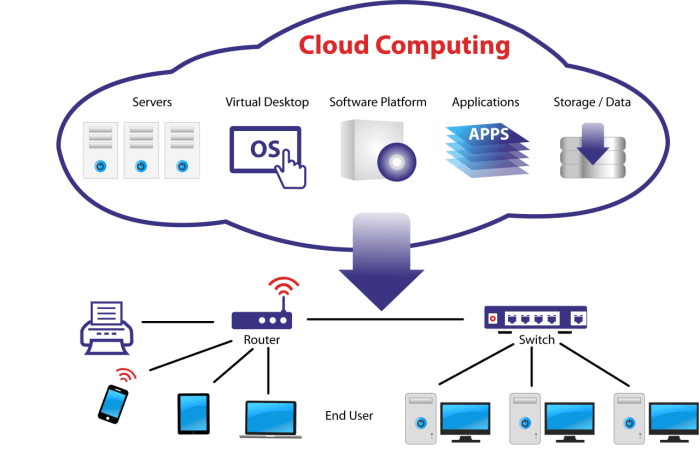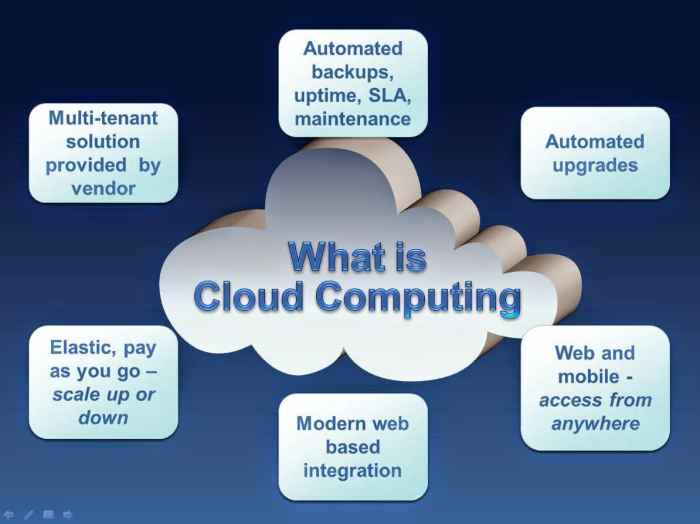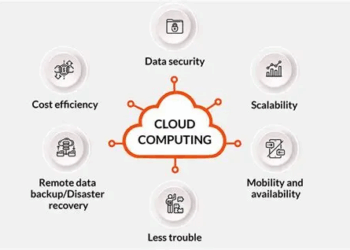
Exploring the intricate world of Cloud Computing and Its Role in Modern Information Systems, this article delves into the key components and benefits of this cutting-edge technology.
As we navigate through the various types of cloud computing services and their impact on modern information systems, a clearer picture emerges of how this innovation is shaping the digital landscape.
Overview of Cloud Computing
Cloud computing is a technology that allows users to access and store data and applications over the internet instead of on local servers or personal computers. This shift to the cloud has revolutionized the way businesses and individuals manage their information systems.
Key Components of Cloud Computing
- Infrastructure as a Service (IaaS): Offers virtualized computing resources over the internet, such as virtual machines, storage, and networking.
- Platform as a Service (PaaS): Provides a platform allowing developers to build, deploy, and manage applications without worrying about the infrastructure.
- Software as a Service (SaaS): Delivers software applications over the internet on a subscription basis, eliminating the need for local installation.
Benefits of Cloud Computing in Information Systems
- Scalability: Cloud computing allows for easy scaling of resources up or down based on demand, providing flexibility and cost-efficiency.
- Cost Savings: By eliminating the need for on-premises hardware and maintenance costs, cloud computing can result in significant savings for organizations.
- Accessibility: Users can access their data and applications from anywhere with an internet connection, enabling remote work and collaboration.
Comparison with Traditional On-Premises Solutions
- Cost: On-premises solutions require significant upfront investments in hardware and maintenance, while cloud computing offers a pay-as-you-go model, reducing costs.
- Scalability: Traditional solutions may face limitations in scaling resources, whereas cloud computing provides on-demand scalability to meet changing needs.
- Maintenance: Cloud computing providers handle maintenance and updates, relieving organizations of the burden of managing physical infrastructure.
Types of Cloud Computing Services

In cloud computing, there are three main service models that cater to different needs and requirements of users. These models are Infrastructure as a Service (IaaS), Platform as a Service (PaaS), and Software as a Service (SaaS).
Infrastructure as a Service (IaaS)
IaaS offers virtualized computing resources over the internet. Users can rent IT infrastructure like servers, storage, and networking on a pay-as-you-go basis. Popular examples of IaaS providers include Amazon Web Services (AWS), Microsoft Azure, and Google Cloud Platform.
Platform as a Service (PaaS)
PaaS provides a platform allowing developers to build, deploy, and manage applications without worrying about the underlying infrastructure. Examples of PaaS providers include Heroku, Microsoft Azure App Service, and Google App Engine.
Software as a Service (SaaS)
SaaS delivers software applications over the internet on a subscription basis. Users can access these applications through a web browser without needing to install or maintain any software. Well-known SaaS providers are Salesforce, Microsoft 365, and Google Workspace.
Public, Private, and Hybrid Cloud Deployments
In addition to the service models, cloud computing deployments can also vary in terms of their accessibility and management. Public cloud deployments are hosted by third-party providers and accessible to multiple users over the internet. Private cloud deployments, on the other hand, are dedicated to a single organization and can be hosted on-premises or by a third-party provider.
Hybrid cloud deployments combine elements of both public and private clouds, allowing organizations to leverage the benefits of both models.
Role of Cloud Computing in Modern Information Systems

Cloud computing plays a crucial role in modern information systems by enabling scalability, flexibility, data storage, accessibility, collaboration, and remote work capabilities.
Scalability and Flexibility
Cloud computing allows organizations to scale their IT resources up or down based on demand, without the need for significant upfront investments in hardware or infrastructure. This flexibility enables businesses to adapt quickly to changing market conditions and easily accommodate growth without incurring high costs.
Data Storage and Accessibility
Cloud computing provides a centralized platform for storing and accessing data, making it easier for employees to collaborate and access information from anywhere with an internet connection. This accessibility ensures that data is always up-to-date and available to those who need it, improving overall efficiency and productivity.
Enhancing Collaboration and Remote Work Capabilities
Cloud computing tools and services facilitate seamless collaboration among team members, regardless of their physical location. This capability is particularly crucial in today’s globalized and remote work environments, where employees need to work together on projects in real-time. By enabling remote work capabilities, cloud computing enhances productivity, flexibility, and work-life balance for employees.
Security Considerations in Cloud Computing
When it comes to cloud computing, security is a top concern for organizations as they entrust their sensitive data to third-party providers. Understanding the common security challenges and best practices for securing data in the cloud is essential for maintaining the integrity and confidentiality of information.
Common Security Challenges in Cloud Computing
- Lack of transparency: Organizations may not have full visibility into the security measures implemented by cloud service providers, leading to uncertainty about data protection.
- Data breaches: Cloud environments are susceptible to cyber attacks, potentially resulting in unauthorized access to sensitive information.
- Compliance issues: Meeting regulatory requirements for data protection can be challenging in the cloud, especially when data is stored in multiple jurisdictions.
- Data loss: Accidental deletion or corruption of data can occur in the cloud, necessitating robust backup and recovery strategies.
Best Practices for Securing Data in the Cloud
- Implement strong access controls: Ensure that only authorized users have access to sensitive data and resources in the cloud.
- Encrypt data: Utilize encryption techniques to protect data both in transit and at rest, safeguarding it from unauthorized access.
- Regularly monitor and audit activities: Keep track of user actions and system events in the cloud to detect any suspicious behavior or security incidents.
- Update security measures: Stay current with security patches and updates to mitigate the risk of vulnerabilities being exploited by attackers.
Importance of Encryption and Access Controls in Cloud Environments
Encryption plays a critical role in securing data in the cloud by encoding information in a way that only authorized parties can decipher it. Access controls help prevent unauthorized users from accessing sensitive data and resources, limiting the risk of data breaches and unauthorized disclosures.
Final Conclusion

In conclusion, Cloud Computing stands as a pivotal force in revolutionizing information systems, offering unparalleled scalability, security, and collaboration opportunities. As we look towards the future, the role of cloud computing is set to expand even further, driving innovation and efficiency across various industries.
Frequently Asked Questions
What are the security challenges associated with cloud computing?
Security challenges in cloud computing include data breaches, data loss, insecure APIs, and account hijacking.
How does cloud computing enhance collaboration?
Cloud computing facilitates real-time collaboration by allowing users to access and edit documents simultaneously from different locations.
What are the main service models in cloud computing?
The main service models in cloud computing are IaaS (Infrastructure as a Service), PaaS (Platform as a Service), and SaaS (Software as a Service).
What is the impact of cloud computing on data storage?
Cloud computing provides scalable and cost-effective data storage solutions, reducing the need for on-premises infrastructure.













